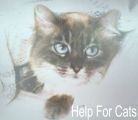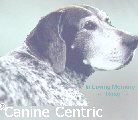Cats & Christmas Trees--got any pointers for me??
-
HMB003
Cats & Christmas Trees--got any pointers for me??
For the last several years, we've had a 4' tall fiberoptic creation for a Christmas tree. This year I want a REAL tree. i'm just not sure what kind of reaction to expect from the cats--whether they'll try to climb it or wreck in, or just stare at it. comments & advice, please. and Merry Christmas.
Re: Cats & Christmas Trees--got any pointers for me??
Well, along that note.....for safety:
BEWARE THE TREE
Angel hair, spun glass, attracts cats because of its airy movement. It is extremely fibrous, and a playful encounter can cause mechanical injury to the eye and skin. It can also wrap around the base of the tongue and cause gagging and retching until removed. If ingested, it can irritate the gastrointestinal tract.
Artificial trees, either plastic or aluminum, contain no known toxic materials. However, if a dog chews on branches, pieces may lodge in the throat or stomach and cause an obstruction.
Bubble lights are generally safe. However, older styles contain methylene chloride. Breaking and ingesting the contents of one bulb is unlikely to be a problem in most domestic animals. However, large breed dogs eating an entire string may require veterinary care.
Christmas tree water additives may contain substances harmful to pets if they drink them. Read the label carefully before use and keep your pets away from the water.
Pine needles can get stuck between footpads or even in the intestine if ingested.
Snow sprays are normally an inert substance mixed with a propellant. Dried particles pose an aspiration risk or foreign body obstruction from ingestion.
Tinsel, which is usually about 40 percent tin and 60 percent lead, are not digestible. Ingestion may result in string type foreign body or pieces of tinsel wrapped around the base of the tongue, which requires removal by a veterinarian.
Tree ornaments made from plastic, glass, styrofoam and a variety of other materials, may result in a foreign body obstruction. Ingestion of the string, ribbon, and fibrous material can wrap around the base of the tongue or even be swallowed, requiring removal by a veterinarian. Sharp or breakable ornaments need to be kept away from curious pets as they may cause cuts and lacerations.
Paint on the ornaments is generally not cause for alarm, although antique ornaments and decorations may have been painted with a lead base paint. This may present a problem depending on the size of the ornament in relation to the weight of the animal.
Shellac ornaments, most typically made from bread dough or other food items, may cause foreign body obstruction, but are not toxic and generally pass through the digestive tract without incident.
AROUND THE HOUSE
Electrical cords need to be examined before use and kept out of the reach of pets. Frayed light cords cause shock or burns and chewing on cords can cause death.
Glitter, small pieces of a nontoxic metal, is an aspiration risk for small animals, but poses no risk of poison.
Lit candles should always be watched closely as they be knocked over by pets and cause a fire. Poorly secured trees with lit lights can also be knocked over by pets and start a fire.
Party items such as alcohol, bones, cigarettes and sweets should be kept far away from pets. Ingestion of any of these poses a real threat that may be deadly.
Plants such as mistletoe and holly pose a real threat to animals if ingested.
Snow globes/scenes are comprised of plastic or glass domes that may cause foreign body obstruction when chewed and swallowed. The liquid portion inside is nontoxic, containing water and insoluble calcium carbonate. Rarely, the water is contaminated with bacteria and vomiting and diarrhea will result. If this occurs, contact your veterinarian immediately.
THE FIRE MAY NOT BE SO DELIGHTFUL
Colored crystals pose an aspiration risk and ingestion may cause irritation to the mouth and gastrointestinal tract. Some crystals may be corrosive and cause chemical burns to the mouth, esophagus and stomach. If an animal eats a large amount, the possibility of heavy metal toxicity exists. A veterinarian should evaluate each case as treatment depends on the exact product.
Synthetic fireplace cones and logs may be composed of several different substances, including wax, sawdust and compressed newsprint. Some products contain metal salts, like copper, to produce color. Larger dogs sometimes chew up enough to cause a problem. Generally, ingestion of waxy products results in stomach upset and diarrhea while sawdust and newsprint can cause a foreign body obstruction.
For more information and tips about holiday and travel safety for pets, call or visit your family veterinarian.
NSAL America/Prosar International Poison Control Center:
(888) 232-8870
National Animal Poison Control Center: 1-888-426-4435
BEWARE THE TREE
Angel hair, spun glass, attracts cats because of its airy movement. It is extremely fibrous, and a playful encounter can cause mechanical injury to the eye and skin. It can also wrap around the base of the tongue and cause gagging and retching until removed. If ingested, it can irritate the gastrointestinal tract.
Artificial trees, either plastic or aluminum, contain no known toxic materials. However, if a dog chews on branches, pieces may lodge in the throat or stomach and cause an obstruction.
Bubble lights are generally safe. However, older styles contain methylene chloride. Breaking and ingesting the contents of one bulb is unlikely to be a problem in most domestic animals. However, large breed dogs eating an entire string may require veterinary care.
Christmas tree water additives may contain substances harmful to pets if they drink them. Read the label carefully before use and keep your pets away from the water.
Pine needles can get stuck between footpads or even in the intestine if ingested.
Snow sprays are normally an inert substance mixed with a propellant. Dried particles pose an aspiration risk or foreign body obstruction from ingestion.
Tinsel, which is usually about 40 percent tin and 60 percent lead, are not digestible. Ingestion may result in string type foreign body or pieces of tinsel wrapped around the base of the tongue, which requires removal by a veterinarian.
Tree ornaments made from plastic, glass, styrofoam and a variety of other materials, may result in a foreign body obstruction. Ingestion of the string, ribbon, and fibrous material can wrap around the base of the tongue or even be swallowed, requiring removal by a veterinarian. Sharp or breakable ornaments need to be kept away from curious pets as they may cause cuts and lacerations.
Paint on the ornaments is generally not cause for alarm, although antique ornaments and decorations may have been painted with a lead base paint. This may present a problem depending on the size of the ornament in relation to the weight of the animal.
Shellac ornaments, most typically made from bread dough or other food items, may cause foreign body obstruction, but are not toxic and generally pass through the digestive tract without incident.
AROUND THE HOUSE
Electrical cords need to be examined before use and kept out of the reach of pets. Frayed light cords cause shock or burns and chewing on cords can cause death.
Glitter, small pieces of a nontoxic metal, is an aspiration risk for small animals, but poses no risk of poison.
Lit candles should always be watched closely as they be knocked over by pets and cause a fire. Poorly secured trees with lit lights can also be knocked over by pets and start a fire.
Party items such as alcohol, bones, cigarettes and sweets should be kept far away from pets. Ingestion of any of these poses a real threat that may be deadly.
Plants such as mistletoe and holly pose a real threat to animals if ingested.
Snow globes/scenes are comprised of plastic or glass domes that may cause foreign body obstruction when chewed and swallowed. The liquid portion inside is nontoxic, containing water and insoluble calcium carbonate. Rarely, the water is contaminated with bacteria and vomiting and diarrhea will result. If this occurs, contact your veterinarian immediately.
THE FIRE MAY NOT BE SO DELIGHTFUL
Colored crystals pose an aspiration risk and ingestion may cause irritation to the mouth and gastrointestinal tract. Some crystals may be corrosive and cause chemical burns to the mouth, esophagus and stomach. If an animal eats a large amount, the possibility of heavy metal toxicity exists. A veterinarian should evaluate each case as treatment depends on the exact product.
Synthetic fireplace cones and logs may be composed of several different substances, including wax, sawdust and compressed newsprint. Some products contain metal salts, like copper, to produce color. Larger dogs sometimes chew up enough to cause a problem. Generally, ingestion of waxy products results in stomach upset and diarrhea while sawdust and newsprint can cause a foreign body obstruction.
For more information and tips about holiday and travel safety for pets, call or visit your family veterinarian.
NSAL America/Prosar International Poison Control Center:
(888) 232-8870
National Animal Poison Control Center: 1-888-426-4435
..........Traci

